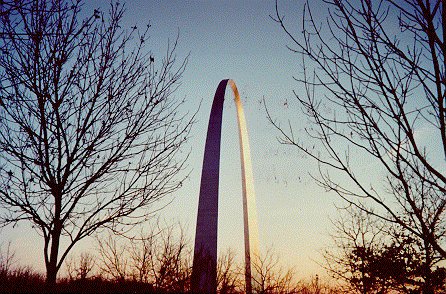
It was in early 1995 that I first saw the Gateway to the West arch. At some 630 feet (around 192m) it certainly cuts an imposing figure over the city of St Louis. Looking suspiciously like a lost half of a giant McDonalds arch pair it oversees the Mississippi river to one side and the city to the other.
Somehow St Louis' sewage treatment plant works as a giant magnet for travellers new to the city. This photo was taken from not too far along from the plant, when the arch becomes clearly visible. It is still some kilometres away yet and yet it still dominates the sky.

To make matters even more fun St Louis has a somewhat confusing road system that feels like it has been taken to with a jackhammer. After navigating these dangers, and avoiding looking too ill when seeing the Casinos, one can park your car in a large underground carpark. Clambering up the stairs you come out into a park area that greats you with this view.

The park itself is quite pleasant in an ordered kinda way. I remarked to my friend at the time that the landscaper, who had laid the garden out, looked likely to have studied some of Capability Brown's [1] designs but not really quite grasped what CB was doing. The park was smooth but way too regular and artificial looking with a line of trees following the path in regimented order. And no trees near the park lake.
It struck me as a shame somehow, the park could be so much more beautiful and fun with a little more care and a slight redesign of the layout.
As always though the Arch itself loomed large. Now that I was close to it the full scale of the thing began to come home. It's stainless steel skin gleamed in even the meagre winter sunlight available, forming a shimmering hoop in some massive game of croquet.
Standing underneath the exact centre of the Arch and looking up yields this dizzying view.

Not visible in the jpeg, but visible in the photo proper, is a small row of slits up near the top of the arch. These are the windows from the observation deck. I sorta wish they were visible in the image because they do bring home the scale of the structure somewhat, but the size of the necessary image was prohibitive.
Descending under the Arch takes you into a museum about the colonisation and expansion of the American 'West'. Taking a very superficial look I couldn't but feel slightly dismayed at the atmosphere of the place. It all seemed proud of the achievements of the colonisers with little recognition of the price of those same achievements. I can't help but wonder how an American Indian would feel about the structure.
The ride to the top is obviously a popular attraction as the tickets for the day were almost sold out by the time we had arrived in mid morning. Still, gaining seats on the second to last ride of the day, we secured our trip to the top of the monument. After seeing other parts of the city for most of the day, including the botanical gardens - well worth the visit, we returned to await the trip up the structure.
Standing around for seemingly interminable hours, in reality about twenty minutes, we finally boarded the tram/lift system. Now for people who, like me, are more than about 5'10" these lift cars are diabolical. The are cramped and small, obviously built for average or smaller people. I suddenly had a lot of empathy for sardines in a can. And I had to literally control my breathing in order to not squeeze co-passengers too much. I also had my head jammed against the ceiling of the lift, and I am only a bit over 6'1", so that I felt every bump on the way up and down again.
I recommend leaving bags, coats and generally as much as possible behind in your car - don't try to take it up the lift with you. Once at the top things are somewhat more spacious. Which gives you time to recover from the lift journey. That said and done the view itself is nice. It would be impressive but for the dull nature of it. One side is city-scape of St Louis and the other side is a brief bit of river with industrial city-scape on the other side. Throw in some city smog and the result is somewhat under-whelming, verging on the ugly.
[1] From my meagre acquaintance with Capability Brown, through a TV show about historical gardens, I understand he laid out gardens to be an orderly form of nature. Smooth curves and artfully natural seeming rocks and tree copses dominate.
But by far and above the only tell-tale that this wasn't a natural garden would be in the neatness of the garden. Otherwise, at his best, the landscape seems entirely natural. Of course I could be mis- interpreting what the documentary had to say and be speaking a load of cobblers.
Update: 12/4/1999 It is interesting to note the number of people who comment that I am being unfavourable towards the monument in this page. I'd like to clarify a little in that I am quite impressed with the monument itself, it's an engineering and design marvel that is definitely quite awe-inspiring to see in person. What I am less than impressed with is more the setting it is in. St. Louis, when I passed through, had a lot of rough edges that made the experience slightly tainted. (Although I do want to stress that their botanical gardens were simply wonderful.)
And, mayhap from being spoiled in New Zealand with a surfeit of gorgeous scenery, I was distinctly dismayed with the primary view being afforded by the monument being mostly cityscape.